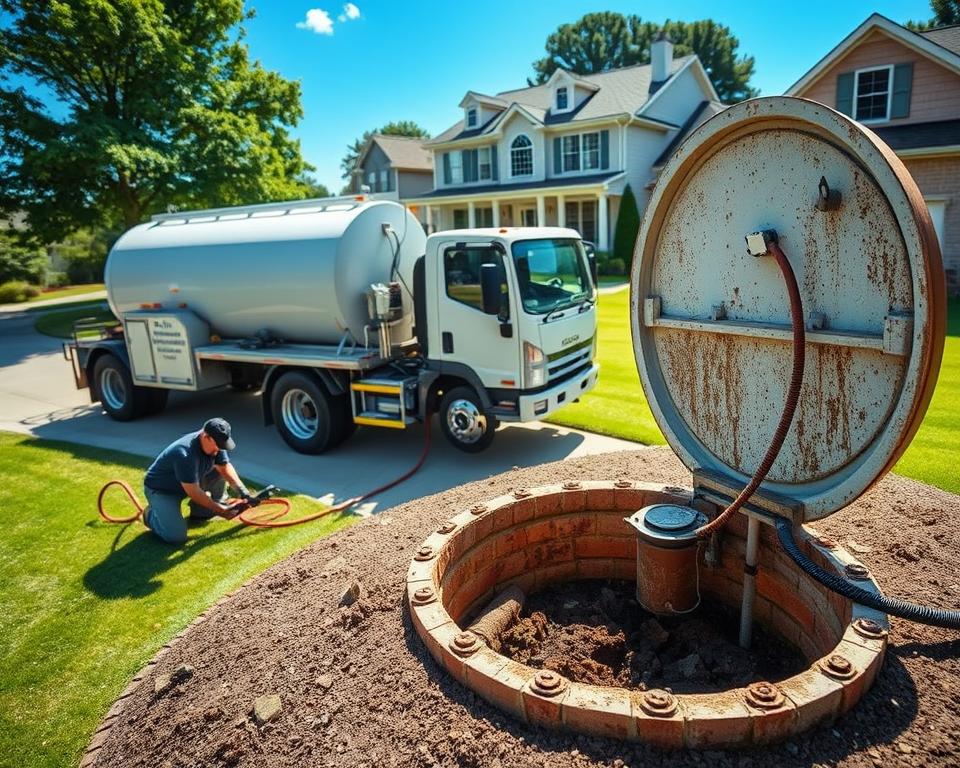Septic Aerator Unit: Comprehensive Guide for Homeowners
Do you sometimes think about what drives your aerobic septic system’s efficiency? The air Pump in your Septic system is the often-overlooked workhorse indispensable for your system. In this article, property owners will acquire practical insight on the device’s function. It’s essential for a healthy, effective Septic tank.
Knowing the importance of a Septic tank air Pump can improve your Septic system’s performance using septic tank inspection near me. It also secures your asset value and surrounding ecosystem. This guide will introduce All in Sanitation, a reputable Septic industry specialist. They’re eager to fulfil your Septic aerator Pump requirements.
Core Takeaways
- The Septic air Pump is crucial for oxygen-based Septic setups.
- Properly caring for your Septic system air Pump can optimize overall system operation.
- Periodic reviews lengthen the durability of your Septic tank air Pump.
- Selecting the correct Septic aerator Pump is critical for optimal operation.
- All in Sanitation provides tailored services for Septic air Pump requirements.
Getting to Know Aerobic Septic Solutions
Aerobic Septic systems present a more effective waste treatment option by supplying oxygen. This technique employs aerobic bacteria thriving in well-oxygenated environments. These bacteria are better in processing organic matter. With the help of Septic aerator Pumps, these systems deliver a continuous oxygen supply, accelerating the waste decomposition process.
These systems shine in decreasing sludge buildup, because of the hard work of aerobic bacteria. This decrease in solid waste means less maintenance and tank emptying is necessary. Additionally, they efficiently treat wastewater, producing little to no smell. This creates a more pleasant environment for homeowners and the community as a whole.
To ensure these systems work successfully, it’s crucial to know the key Septic system components. These include the Septic tank, treatment chamber, and effluent Pump. Each element serves a key function, especially the air Pump. It forces oxygen into the tank, essential for the aerobic bacteria’s efficiency.
Role of the Septic Air Pump
The Septic air Pump is central in the running of aerobic Septic systems. It operates as the system’s “air provider,” pushing the needed oxygen needed. This oxygen enables aerobic bacteria to thrive and process waste quickly. If the Pump breaks, the system’s efficiency declines, causing sludge accumulation and possible odors.
Such issues can undermine Septic system operations and cause environmental hazards. By realizing how essential the Septic air Pump is, homeowners can act preemptively. They can secure its peak function through consistent upkeep. This stops failures, prevents costly repairs, and preserves the aerobic system’s integrity.
Primary Gains of Using a Septic Air Pump
Utilizing a Septic air Pump significantly boosts the efficiency of Septic systems. Septic air Pumps are crucial as they accelerate the breakdown of waste. This is accomplished by oxygenating the treatment process, promoting aerobic bacteria growth. These bacteria are critical for effective waste treatment.
They’re also instrumental in cutting foul smells. Due to more active aerobic processes, waste decomposes faster, thus diminishing odors. This provides a fresher environment for homeowners.
Another valuable benefit is the drop in sludge buildup. Consequently, tanks demand less frequent Pumping, reducing both money and time. Greater processing not only lowers bills but also prolongs the lifespan of the drain field.
Proper care of these Pumps well means minimal repair costs and adhering to regulatory standards. Thus, the benefits of Septic air Pumps go beyond being for homeowners. They also enhance environmental health by raising waste management practices.
| Benefit | Description |
|---|---|
| Fast Waste Breakdown | Enhanced aerobic activity quickens the decomposition process. |
| Minimized Odor Emissions | Improved treatment efficacy results in fewer odors. |
| Reduced Sludge Buildup | Minimal Pumping and maintenance are necessary. |
| Extended Drain Field Life | Better treatment equals a healthier drain field. |
| Cost Savings | Lower probability of repairs and regulatory compliance cost. |

Finding a Suitable Septic Air Pump
Choosing the correct Septic air Pump is critical for an effective aerobic system. Homeowners need to evaluate various factors for the proper choice. The capacity of the tank and the airflow specifications play a crucial role the Pump’s performance.
To make an informed choice, it’s important to be aware of the air Pumps available. There are mainly two types: linear diaphragm Pumps and rotary vane Pumps. Each comes with unique benefits, which should be paired with your home’s specific needs and daily load.
Electric efficiency also deserves attention. Choosing a Pump that lowers energy use while achieving the needed airflow can yield meaningful reductions. Assistance from All in Sanitation consultants can be extremely useful. They confirm the Pump you choose matches your system’s requirements precisely.
Major Kinds of Septic Air Pumps
Homeowners can decide more effectively by knowing the various Septic air Pumps available. There are mainly two types: diaphragm Pumps and rotary vane Pumps. Each has its individual functions and benefits.
Diaphragm Pumps, famous for their hushed operation, are commonly used for residential Septic systems. They deliver energy efficiency while delivering reliable air delivery. Their dependable performance is ideal for smaller systems, meeting the needs of many homeowners.
Rotary vane Pumps, however, are designed for higher-capacity or commercial systems. These Pumps produce more power, essential in handling bigger loads. Their durable build delivers efficient operation in heavy-duty Septic systems.
| Type of Pump | Best Use | Advantages |
|---|---|---|
| Diaphragm Pumps | Residential Systems | Quiet operation, energy-efficient, reliable air flow |
| Rotary Vane Pumps | Larger or Commercial Systems | Powerful performance, high capacity, durable construction |
Recognizing the contrasts in Septic air Pumps is vital for upgrades or replacements. Each Pump type delivers distinct traits to meet various needs. This secures best performance for any system.
Clues Pointing to a Septic Air Pump Replacement
Homeowners must be alert to Pump failure signs in their Septic systems. Some symptoms suggest the need for a Septic air Pump replacement. These help maintain smooth operation. Identifying these promptly stops major issues.
Signs of potential problems include:
- Unusual noises from the Pump, like rattling or trembling, might show internal damage.
- A clear lack of air output means the Pump isn’t operating efficiently, reducing efficiency.
- Repeated electrical problems, such as tripped breakers or lights dimming, could point to overloading.
- Visible damage on the Pump unit, with cracks or leaks, calls for quick action.
- Unpleasant odors in the yard often suggest a compromised Pump, showing ineffective effluent aeration.
Recognizing these signs early heads off expensive repairs or total system failure. Conducting routine inspections assists in finding these issues. It also clarifies if you ought to have a new Septic air Pump.
Upkeep Advice for Your Septic Air Pump
For an effective Septic air Pump, consistent service is vital. This guarantees that your system runs well. Homeowners can follow several straightforward care strategies for optimal results.
Every six months, conduct a thorough inspection for wear or damage. It is also crucial to change the filters as indicated. This prevents clogs that could hurt efficiency.
The Pump should sit on a firm base to cut vibrations, which could harm it over time. A protective cover is essential too. It defends against debris and water, sustaining the Pump’s functionality.
Proper maintenance can significantly extend the life of your Pump. In turn, this benefits the Septic system’s performance in general.
| Maintenance Task | Frequency | Benefits |
|---|---|---|
| Inspect Pump for damage | Every 6 months | Detects damage sooner |
| Replace filters | As needed | Enhances operation |
| Check surface stability | Annually | Reduces vibrations |
| Clear debris around Pump | Monthly | Prevents clogs |
Installing Your Septic Air Pump
Accurate installation of your Septic air Pump is critical for its optimal operation. Initially, choose a reliable, moisture-free area for placement. The chosen spot should securely accommodate the Pump’s weight without issue.
To effectively fit your Pump on your own, heed the following guidelines:
- Prepare all necessary items, including the Pump, a power source, and hose fittings.
- Thoroughly review the manufacturer’s guidelines before beginning your installation.
- Ensure every connection is sealed to eliminate air leaks that compromise performance.
- After assembly, complete a test to ensure the system works as intended.
If the installation process appears difficult, reach out to All in Sanitation. Their professionals can prevent common errors, confirming your setup adheres to strict safety requirements.
Why Choose All in Sanitation for Your Septic Air Pump Requirements
When choosing a Septic service provider, the choice is crucial. All in Sanitation distinguishes itself by supplying dependable Septic air Pumps. They satisfy different homeowner requirements with a comprehensive selection of top-tier products. This makes sure customers secure an exact match for their Septic systems.
What really sets apart All in Sanitation is beyond their broad product lineup. Their dedication to exceptional customer service is also noteworthy. Homeowners enjoy knowledgeable support, steering them toward trusted Septic solutions. This partnership is essential to customize each solution to match specific needs.
All in Sanitation also focuses on aftercare to guarantee lasting satisfaction. Their commitment extends beyond the initial sale. They supply ongoing support to keep Septic systems operating efficiently for the years ahead.
Financial Aspects for Septic Air Pumps
Appreciating the expenses connected with Septic air Pumps is key for homeowners with aerobic Septic systems. At first, one faces the price tag, which includes the Pump and needed accessories. Installation expenses change, based on the system’s complexity and any changes required.
Ongoing upkeep forms an additional cost layer. Routine checks can prevent bigger issues, which can mean savings. Homeowners should set aside funds for Septic maintenance to keep the Pump’s effectiveness and durability. Such planning prevents expensive repairs later on, demonstrating the benefit of proactive maintenance.
| Cost Component | Average Cost Range |
|---|---|
| Septic Air Pump | $500 – $1,200 |
| Installation | $300 – $800 |
| Annual Maintenance | $150 – $400 |
| Potential Repair Costs | $1,000 – $5,000 |
Itemizing Septic air Pump expenses into specific parts assists homeowners in financial preparation. This comprehensive approach ensures the system’s smooth operation and their confidence.
In Summary
For homeowners with aerobic Septic systems, servicing Septic systems is vital. The suitable Septic air Pump enhances waste processing and extends your system’s life. Sticking with regular upkeep and promptly addressing issues sidesteps costly fixes and disruptions.
Picking a Septic air Pump calls for deliberation. This guide showed how to make smart choices about installation and replacement. With All in Sanitation’s guidance, you can handle your Septic systems’ complexities with confidence.
Looking after your Septic air Pump enhances your system’s efficiency and life span. It ensures a reliable and successful operation over time. Don’t forget, your home’s wastewater management is strongly influenced by consistent upkeep.


